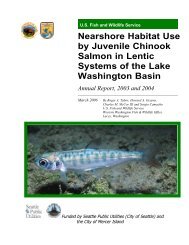2006 Water Comprehensive Plan - City of Bellevue
2006 Water Comprehensive Plan - City of Bellevue
2006 Water Comprehensive Plan - City of Bellevue
- No tags were found...
Create successful ePaper yourself
Turn your PDF publications into a flip-book with our unique Google optimized e-Paper software.
. At the time the backflow prevention assembly was installed its installation was approved by the city asappropriate for the degree <strong>of</strong> hazard; andc. The backflow prevention assembly does not meet the criteria for upgrading as required in subsection (C)(2)<strong>of</strong> this section.2. All existing nonconforming backflow prevention assemblies shall be replaced and upgraded to current standardsat such time as any <strong>of</strong> the following conditions exist:a. The assembly fails to operate properly;b. The assembly fails required annual testing and certification;c. The assembly requires continual and excessive repair or maintenance;d. The degree <strong>of</strong> hazard at the premises increases from that which existed at the time the assembly wasinstalled; ore. The water service, fire sprinkler system or plumbing are, or have been, modified.3. When the utility discovers previously unknown and/or unprotected cross-connections, the utility shall notify theproperty owner <strong>of</strong> the cross-connection, the degree <strong>of</strong> hazard, and the cross-connection abatement and control measuresrequired. The property owner shall make provision to implement all required abatement and control measures within thetime frame specified by the utility subject to the enforcement provisions <strong>of</strong> BCC 24.02.250 or state law.D. Inspection, Testing and Certification Requirements.1. All newly installed or relocated backflow prevention assemblies shall be inspected, tested and certified by theutility, except that newly installed irrigation system backflow prevention assemblies may be tested by a certified privatebackflow prevention assembly tester following city inspection <strong>of</strong> assembly installation.2. All backflow prevention assemblies shall be inspected, tested and certified annually by the utility or a privatebackflow prevention assembly tester certified by the Washington State Department <strong>of</strong> Health.E. Costs and Fees. The property owner shall be responsible for paying all utility costs and fees associated with theinstallation, inspection, testing, certification, repair, replacement or upgrade <strong>of</strong> backflow prevention assemblies. See BCC24.02.250 regarding fees. (Ord. 4751 § 3, 1995.)Element 2: The purveyor shall develop and implement procedures and schedules forevaluating new and existing service connections to assess the degree <strong>of</strong> hazard posed bythe consumer's premises to the purveyor's distribution system…1) Evaluations <strong>of</strong> new construction and sites are completed through the UtilitiesDevelopment Review process and <strong>City</strong>’s Plumbing Inspection plan review.2) Utilities cross-connection program has been active since the mid 1980’s when initialevaluations were conducted on commercial sites. Evaluations <strong>of</strong> residential sites aredone through the PCD plan review process and individually as time permits.3) Commercial change <strong>of</strong> use and Tenant Improvements are evaluated through the PCDplan review process. Periodic reevaluations <strong>of</strong> service connections are prioritizedbased on the degree <strong>of</strong> hazard determined during the initial evaluation. In order <strong>of</strong>importance: (1) Table nine sites annually (exception: a; continue to receivesatisfactory test results on an annual basis b; complex plumbing systems with limitedaccess agree to test on a bi-annual basis (i.e. Overlake Hospital). (2) Change <strong>of</strong> use.Most frequently accomplished through the plumbing and plan review process (3)commercial/retail connections 4) residential connections as time permits, and withpublic outreach and education.Element 3: …develop and implement procedures and schedules ensuring that…cross connectionsare eliminated…controlled by installation <strong>of</strong> approved backflow preventer…installed inaccordance with requirements…Through <strong>City</strong> Code, the evaluation process, the use <strong>of</strong> “Accepted Practices andProcedures…”, and the DOH list <strong>of</strong> approved assemblies all aspects <strong>of</strong> this element aremet within Utilities cross connection program. Utilities specifically requires morestringent installation practices with the following: 1) Mixed use (multi-family andcommercial/retail) buildings are required to install and RPBA for premise isolation. 2)10-19
















